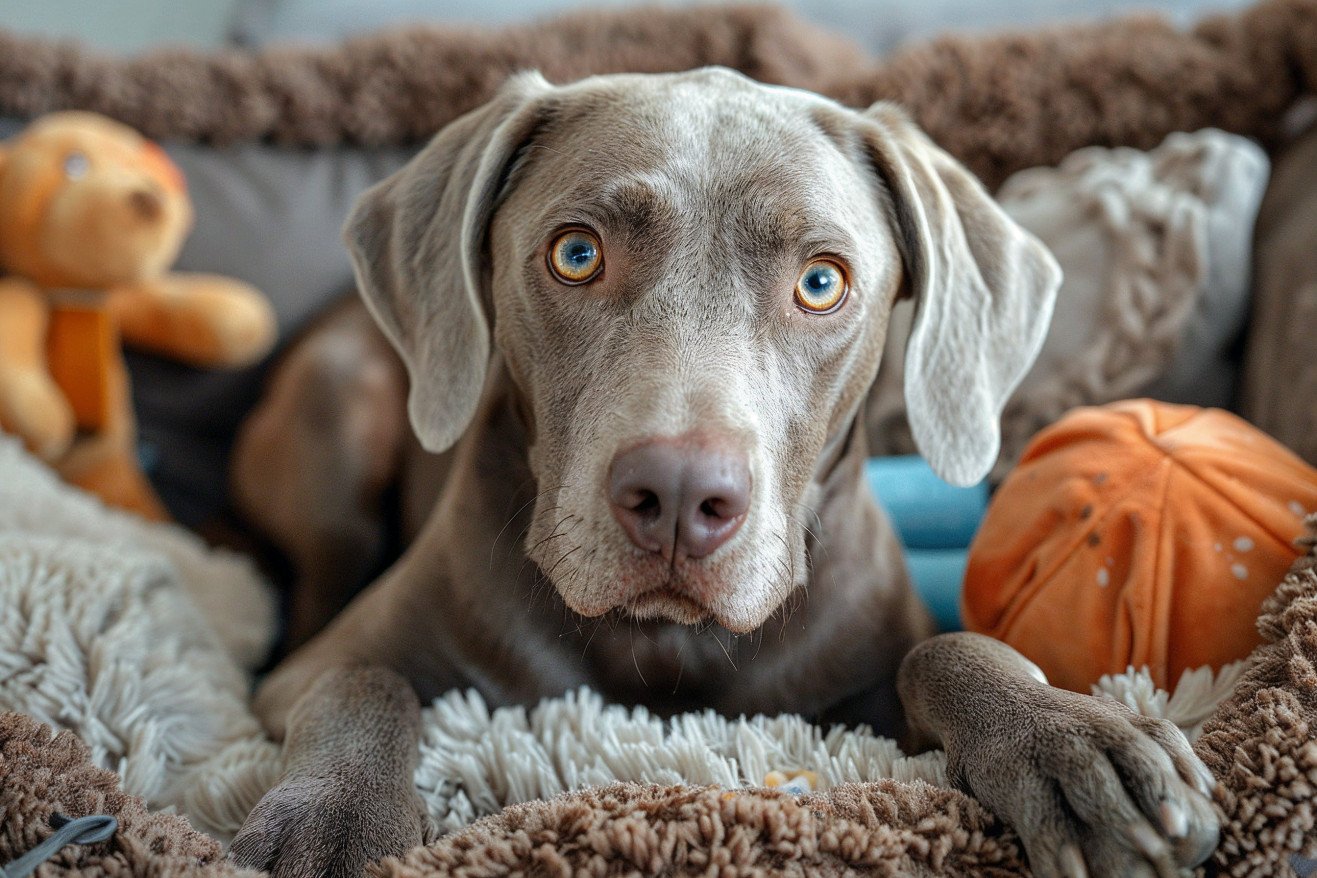Can Dogs Masturbate? What to Know About Normal Canine Behavior
10 March 2024 • Updated 9 March 2024

Although it’s a topic that’s often talked about in hushed tones, the question of whether or not dogs masturbate is still one that’s surrounded by a lot of uncertainty. The short answer is that yes, dogs do masturbate, and it’s a completely normal part of their sexual behavior. Both male and female dogs can masturbate in response to a variety of stimuli, including excitement, stress, play, and medical conditions.
To help you better understand this interesting part of dog behavior, we’ll take a look at studies in veterinary science, ethology, and animal psychology.
We’ll also delve into the reasons behind these behaviors, their potential impact on a dog’s health, and the many ways dogs communicate with one another. By taking this interdisciplinary approach, we hope to give you a more well-rounded view of a topic that’s both widespread and rarely discussed.
Can dogs masturbate?
What’s up with Dog Masturbation?
Masturbation, mounting, and humping are all normal parts of a dog’s sexual behavior, regardless of the dog’s sex or age. PetCareRx notes that dogs, especially when they’re puppies, may start to masturbate, mount, and hump other animals, objects, or even people during play. This can be a way to practice for future mating.
The ASPCA points out that both spayed and neutered and unaltered dogs will exhibit these behaviors, which means that the idea that only unaltered dogs will masturbate, mount, and hump is a myth.
The reasons for these behaviors are complex. Dogs may do these things to let off steam, relieve stress, or simply because it feels good. Psychology Today also notes that these behaviors can be triggered by a variety of emotional states, including excitement and anxiety, not just the commonly assumed dominance and aggression.
In a larger social sense, dogs may use sexual behaviors to communicate with other dogs or in response to other things in their environment. While spaying and neutering can reduce the frequency of these behaviors due to hormonal changes, it doesn’t eliminate them, which suggests that dogs may have evolved to enjoy these behaviors.
Understanding these behaviors in dogs can help us understand the natural range of canine sexual behaviors and the complex ways dogs communicate within their social groups.
Health Risks of Dog Masturbation
While masturbation in dogs is normal, it can sometimes be a sign of other health issues. According to ScienceDirect, urinary tract infections (UTIs), skin allergies, or even priapism can lead to increased genital licking or chewing. This means that pet owners need to be able to tell when their dogs’ behaviors are getting out of hand and may need medical intervention.
In addition, masturbation can be a way for dogs to relieve stress, which can be good for their overall health. However, if masturbation becomes excessive, it can turn into a compulsive disorder, especially if it’s in response to stress, and this can interfere with a dog’s daily life.
If a pet owner notices a big increase in this behavior, it’s important to talk to a vet. This is especially important because, as TruePetStory points out, excessive masturbation needs to be dealt with not just for health reasons but also to prevent potential behavioral issues.
VCA Animal Hospitals recommends that pet owners talk to a vet if their dog’s sexual behavior changes after they’re neutered, as this could be a sign of health problems. In the end, understanding these behaviors can help pets live healthier lives, and knowing when to spot signs of excessive or problematic masturbation is important to their well-being.
Inside the Canine Mind: The Psychology of Dog Masturbation
When it comes to the psychology of dog masturbation, there are a number of different things that can trigger the behavior. According to Psychology Today, the behavior can be caused by a number of different emotional states, including arousal, stress, and anxiety.
If a dog is bored or lonely, they may engage in self-soothing behaviors like masturbation to deal with a lack of stimulation. Meanwhile, Whole Dog Journal says that these behaviors can also be a way for dogs to relieve stress and get away from the pressures of their environment.
In some cases, dogs may develop compulsive disorders that lead to repetitive masturbation behaviors, which can become obsessive and happen in response to specific stressors.
In terms of social behavior, dogs may use masturbation as a way to communicate non-verbally or as a response to environmental stimuli, according to Whole Dog Journal.
Meanwhile, play and exploration, especially during a dog’s early years, are important factors in the development of these behaviors, which can continue into adulthood.
Hormonal Considerations: Understanding Canine Masturbation and Behavior
The interaction of hormones is one of the most important factors in a dog’s sexual behavior, including masturbation. A study in Frontiers by Alejandra Rossi looked at the hormonal correlates of play-soliciting behavior and found that domestic dogs with lower cortisol levels were more likely to show this type of behavior.
This indicates that stress hormones may decrease a dog’s desire to engage in sexual play, while oxytocin, which is known as the “love hormone” because it’s released when people snuggle or bond socially, may increase it.
Neutering and spaying can have a big impact on a dog’s hormones and often lead to a decrease in sexual behaviors. However, a case study in the journal Animals by Paulina Krzeminska found that hormonal changes that occur after neutering don’t always result in a decrease in sexual behaviors, suggesting that other factors are involved.
Age and breed are also important factors in the hormonal side of the equation. Hormonal changes as dogs age can impact sexual behavior, and different breeds may have different patterns due to genetic factors. These factors show the complexity of the biological side of dog masturbation and demonstrate a range of normal, hormone-driven behaviors that are part of the dog’s natural makeup.
Understanding the biological roots of these behaviors helps us understand the full range of dog communication and the potential for misunderstanding.
Understanding the Canine Language of Love
Dogs use a combination of scent marking, body language, and vocalizations to express sexual interest. A study in the journal PMC found that scent is especially important because male dogs can tell if a female is in heat based on the semiochemical signals in her urine.
Meanwhile, a female dog will let males know she’s in estrus through body language, including lifting her hindquarters and wagging her tail. Unfortunately, these signs are often misunderstood by people.
For example, behaviors like mounting or sniffing are often interpreted as sexual when they may actually be related to social dominance or play, according to VCA Animal Hospitals.
This misunderstanding is made worse by anthropomorphism, the tendency to attribute human emotions to animals.
In fact, as VIN explains, a study has shown that mounting, sniffing, and other behaviors are part of a complex social system in dogs that includes dominance, submission, play, and sexual signaling.
Canine Sexual Behavior: An Overview
According to PetCareRx and the ASPCA, sexual behavior and masturbation in dogs are normal and can manifest in a number of ways due to a dog’s biology and psychology. These behaviors can be a result of everything from play and social interactions to stress and arousal, and are therefore not limited to dogs that have not been spayed or neutered.
This is further supported by the fact that these behaviors often continue even after a dog has been spayed or neutered, showing that there is more to these behaviors than just reproduction.
An article in PMC describes dog communication as complex and involving a range of visual, auditory, and olfactory cues. This is often misunderstood because of anthropomorphism, which makes it even more important to understand the ways dogs communicate their sexual readiness or interest.
Part of being a responsible dog owner is understanding these behaviors well enough to know when they are normal and when they might be a sign of a physical or psychological problem.
It is important to continue to fund research and education about dog behavior so that we can continue to learn more about our furry friends. This will help us build stronger relationships with them and ensure their happiness and safety.


